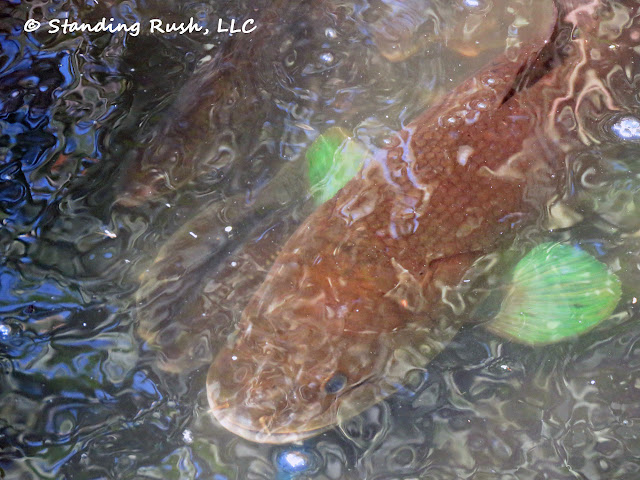 |
| Bowfin (Amia calva) displaying spring/early summer spawning colors; the vibrant turquoise of a mature male can be difficult to fully capture on camera, especially from above |
A couple months back, I briefly introduced the bowfin, a truly prehistoric fish that is actually fairly common on our marsh and throughout the backwaters of the Western Basin of Lake Erie. Thanks to a GoPro camera, I captured some underwater footage of a decent-sized female which I shared on April 12 -- to much fanfare, I might add! I promised more information, so having just stumbled onto the photo above (somehow taken a few weeks ago already), I'm making good on my promise.
Incredibly, bowfins are the only remaining survivor of an otherwise extinct group of ancient fishes that first arose more than 150 million years ago. I'm amazed in doing just a little research at how much is available online in images and in writing about a species that seems very much overlooked in the field.
But I guess it kind of makes sense. While somewhat secretive and most active at night, these relics are anything but inconspicuous. Males are smaller than females, but I'm most accustom to seeing them both in excess of 4-5 pounds -- and on the marsh and in the adjacent estuary females routinely grow to 8-10 pounds or more. Male are easily identified by a distinctive, dark "eye" spot on their caudal/tail fin (a evolutionary distraction technique also seen in moths and butterflies), and their coloration can truly look like something rendered by a Sci-Fi artist or camo designer.
 |
| Other endearing nicknames for the bowfin include, but certainly are not limited to: dogfish, mudfish, grinnel, and my favorite -- the swamp-muskie (photo courtesy of the Ohio Department of Natural Resources, Division of Wildlife) |
Additionally, "swamp-muskies" have many characteristics in common with ancient fish. Like members of the gar family, they have a "primitive" skeleton (part bone, part cartilage) and a "double skull" (an inner layer of cartilage wrapped in bone). By contrast, modern and more recently evolved fish have skeletons made entirely of bone.
Bowfins also provide parental care for their young, an unusual characteristic in modern fish. They are nest builders and voracious nest protectors (guarding eggs and then their tightly schooled offspring longer than any other fish in North America -- often for several months).
Fingerlings and juveniles, like adults, are relentless predators with a hearty appetite. Their preferred forage seems to be crayfish and other crustaceans, but they have been proven to be opportunists -- taking down, invertebrates, leeches, frogs, snakes, small rodents, birds, other fish, and even their own. That said they are not thought to be overly detrimental to the "sport fish" commonly pursued with hook and line. (Although I have heard they can be tasty to eat themselves!)
One final evolutionary adaptation of note: when the oxygen level in waters become depleted, as often happens in warmer shallow water, bowfins will rise to the surface and gulp air into their swim bladder. This organ is uniquely lined (in the bowfin's case) with blood vessels and can serve as a primitive type of lung, aiding in survival until oxygen availability improves.
P.S. Bowfins (without question, a native species) are often mistaken for northern snakeheads (another ominous invasive species). If you encounter one or the other, please make sure you understand and appreciate the difference, so that bowfins can continue to thrive in our waters.
One of my goals for myself and the kids this summer is to net and photograph some of this year's hatch. I'd love to rear young bowfins in an aquarium for a bit. There is so much more to learn about this amazing critter. If you want more info, the best article I've found thus far comes from a post doc who works at the Shedd Aquarium in Chicago: Adventures with Bowfin, North America’s Underdog(fish) -- great photos and it is truly worth the read.
